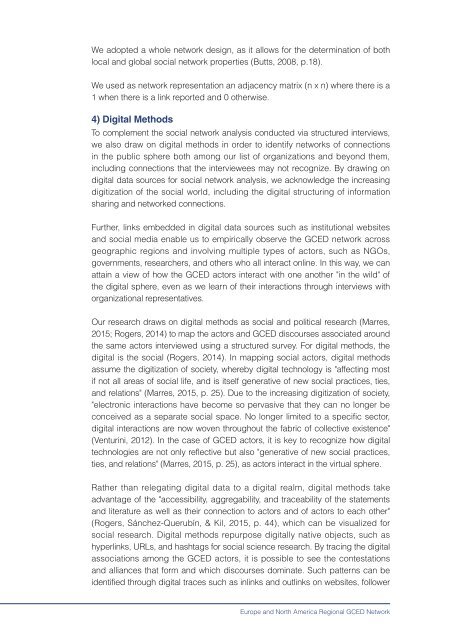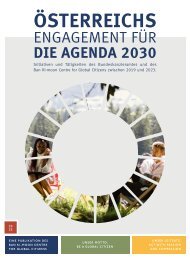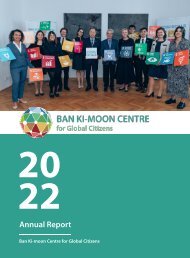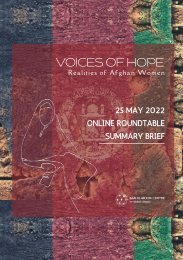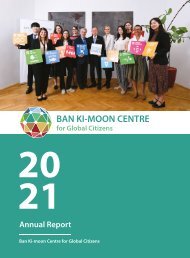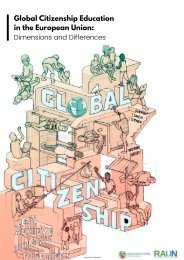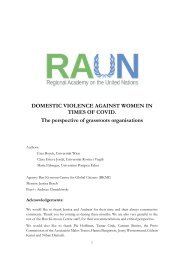Europe and North America Regional GCED Network
The report “Europe and North America Regional GCED Network” is based on a research project funded by Asia-Pacific Centre of Education for International Understanding (APCEIU) and Ban Ki-moon Centre for Global Citizens (BKMC) led by Lynette Shultz (Centre for Global Citizenship Education and Research, University of Alberta) and Massimiliano Tarozzi (International Research Centre on Global Citizenship Education, University of Bologna) as Principal Investigators. The research team was composed of Carrie Karsgaard and Carla Inguaggiato, with the support of Kester Muller and Francis Owusu.
The report “Europe and North America Regional GCED Network” is based on a research project funded by Asia-Pacific Centre of Education for International Understanding (APCEIU) and Ban Ki-moon Centre for Global Citizens (BKMC) led by Lynette Shultz (Centre for Global Citizenship Education and Research, University of Alberta) and Massimiliano Tarozzi (International Research Centre on Global Citizenship Education, University of Bologna) as Principal Investigators. The research team was composed of Carrie Karsgaard and Carla Inguaggiato, with the support of Kester Muller and Francis Owusu.
Create successful ePaper yourself
Turn your PDF publications into a flip-book with our unique Google optimized e-Paper software.
We adopted a whole network design, as it allows for the determination of both<br />
local <strong>and</strong> global social network properties (Butts, 2008, p.18).<br />
We used as network representation an adjacency matrix (n x n) where there is a<br />
1 when there is a link reported <strong>and</strong> 0 otherwise.<br />
4) Digital Methods<br />
To complement the social network analysis conducted via structured interviews,<br />
we also draw on digital methods in order to identify networks of connections<br />
in the public sphere both among our list of organizations <strong>and</strong> beyond them,<br />
including connections that the interviewees may not recognize. By drawing on<br />
digital data sources for social network analysis, we acknowledge the increasing<br />
digitization of the social world, including the digital structuring of information<br />
sharing <strong>and</strong> networked connections.<br />
Further, links embedded in digital data sources such as institutional websites<br />
<strong>and</strong> social media enable us to empirically observe the <strong>GCED</strong> network across<br />
geographic regions <strong>and</strong> involving multiple types of actors, such as NGOs,<br />
governments, researchers, <strong>and</strong> others who all interact online. In this way, we can<br />
attain a view of how the <strong>GCED</strong> actors interact with one another "in the wild" of<br />
the digital sphere, even as we learn of their interactions through interviews with<br />
organizational representatives.<br />
Our research draws on digital methods as social <strong>and</strong> political research (Marres,<br />
2015; Rogers, 2014) to map the actors <strong>and</strong> <strong>GCED</strong> discourses associated around<br />
the same actors interviewed using a structured survey. For digital methods, the<br />
digital is the social (Rogers, 2014). In mapping social actors, digital methods<br />
assume the digitization of society, whereby digital technology is "affecting most<br />
if not all areas of social life, <strong>and</strong> is itself generative of new social practices, ties,<br />
<strong>and</strong> relations" (Marres, 2015, p. 25). Due to the increasing digitization of society,<br />
"electronic interactions have become so pervasive that they can no longer be<br />
conceived as a separate social space. No longer limited to a specific sector,<br />
digital interactions are now woven throughout the fabric of collective existence"<br />
(Venturini, 2012). In the case of <strong>GCED</strong> actors, it is key to recognize how digital<br />
technologies are not only reflective but also "generative of new social practices,<br />
ties, <strong>and</strong> relations" (Marres, 2015, p. 25), as actors interact in the virtual sphere.<br />
Rather than relegating digital data to a digital realm, digital methods take<br />
advantage of the "accessibility, aggregability, <strong>and</strong> traceability of the statements<br />
<strong>and</strong> literature as well as their connection to actors <strong>and</strong> of actors to each other"<br />
(Rogers, Sánchez-Querubín, & Kil, 2015, p. 44), which can be visualized for<br />
social research. Digital methods repurpose digitally native objects, such as<br />
hyperlinks, URLs, <strong>and</strong> hashtags for social science research. By tracing the digital<br />
associations among the <strong>GCED</strong> actors, it is possible to see the contestations<br />
<strong>and</strong> alliances that form <strong>and</strong> which discourses dominate. Such patterns can be<br />
identified through digital traces such as inlinks <strong>and</strong> outlinks on websites, follower<br />
<strong>Europe</strong> <strong>and</strong> <strong>North</strong> <strong>America</strong> <strong>Regional</strong> <strong>GCED</strong> <strong>Network</strong>


